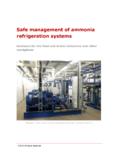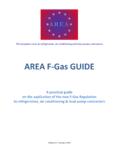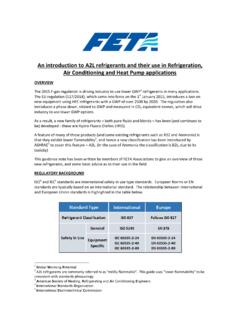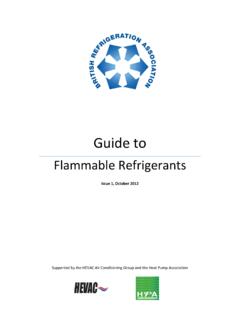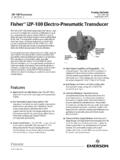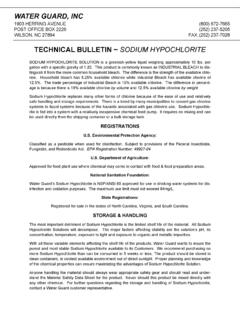Transcription of Refcom is a ESA Group Company TECHNICAL …
1 1 | 3 Refcom is a BESA Group CompanyTECHNICAL BULLETINTB/033: WORKING WITH LOWER FLAMMABILITY REFRIGERANTS1: OBJECTIVEThe objective of this TECHNICAL bulletin is to advise on the changes to working practices required when working with the new generation of A2L refrigerants replacing the higher Global Warming Potential (GWP) HFC gases that are currently the industry norm. A2L is a new safety classification from ASHRAE denoting lower flammability, sometimes referred to as mildly flammable . They generally have a much lower GWP than current common HFC : BACKGROUNDR efrigerantGWPA pplicationsR32675 Small and light commercial AC split systems; next generation hybrid VRF possibility. Performance similar to R410A - average 5% efficiency improvements on like for like is and integral units.
2 Capacity is lower than with R134a - not a drop in retrospective replacement AC replacement for R134aSolstice L20,L40,L41<600 Honeywell replacements for R407C, R404A and R410A being , DR7, DR5A<500 DuPont replacements for R407C, R404A and R410A being 1 The fluorinated greenhouse gases regulation (EC517/2014), commonly referred to as the F Gas Regulation, has introduced a phase down of high GWP gases by limiting the amount of gas that can be placed on the market that limit being expressed in terms of CO2 tonnes equivalent. Table 11 gives an overview of the current A2L alternatives in use or under discussion with an indication of what sector of the market they are applied downside to lowering the GWP of a gas tends to be the increasing of flammability levels or other safety related issues.
3 Many of the replacements for current standard HFCs are mildly flammable and have resulted in the new ASHRAE classification A2L meaning that the gas is flammable but of a lower flammability level than a class 2 gas. In particular the lower flammability tend to be hard to ignite, and have a slow burning velocity of 10 cm/s under test conditions. As such, they are considered to be safe for use in approved systems and can be considered safe for general handling with certain Adapted from table provided by Cool Concerns to A2L article in the ACR Journal September 20152 | 3 TECHNICAL BULLETINTB/033: WORKING WITH LOWER FLAMMABILITY REFRIGERANTS3: BEST InstallationAs long as standard good installation practice is observed then there should be no additional risks involved.
4 RAC80 Design Specification for DX Air Conditioning & Heat Pump Equipment should be referred to, as well as earlier TECHNICAL bulletin TB012: Jointing Methods which describe best practice to be observed while brazing copper pipes together. The use of the inert OFN2 when brazing not only prevents oxidization of the internal surface of the copper, it also displaces any residual refrigerant gas that may be in the pipework. In the case of an installation this should not be an issue, however best practice will guard against any inadvertent release of gas via a faulty or weeping stop valve allowing flammable gas to enter the pipe under Service, maintenance and repair workThis is where more care needs to be taken when working with A2L systems. Refer to TECHNICAL Bulletins TB016: Safe de-brazing and TB023: Refrigerant Recovery for more information.
5 In particular, when recovering any A2L gas it is essential that a recovery machine marked as being suitable for A2L gases is used. Although the gases are rated lower flammability by ASHRAE standards, and are hard to ignite as we have discussed, they remain rated flammable under H&SE DSEAR3 and the ADR4 transport regulations guidelines for the UK. As such they are subject to more intrusive work planning and method requirements as well as for storing and transportation of the gas in bottles. Storage and transportation requirements are in line with what is required currently with acetylene and MAPP gas bottles5. Similarly, it is essential that only leak detectors and other electrical and electronic equipment that is rated as safe for use with A2L refrigerants are used where A2L gases are present.
6 It is essential when attending a site for any repair work, or for routine servicing, that the technician ensures they are aware of what gas is in the system and treats the system as they would for a flammable gas, even if the system label does not state that a flammable gas has been used. As the availability of A2Ls becomes wider and the use more common, there is a chance that an A2L may be used even where it has not been identified. TB016 highlights the dangers of de-brazing pipe joints and components without using an inert gas such as OFN. The inert gas not only prevents oxidization of the internal surface of the copper, it also purges any residual gas embedded in the refrigerant oil that will boil off when heated, creating a pressure rise that can be ejected at high pressure as the weld is melted.
7 This can cause the oil and/or the gas to be ignited as they leave the joint being de-brazed causing injury to operatives and/or Oxygen Free, or dry , Nitrogen3 Dangerous Substances and Explosive Atmosphere Regulations 2002, Health and Safety Executive International Carriage of Dangerous Goods by Road5 The exception to this is HFO1234ze(E) which is classed as non-flammable at 20 C3 | 3 Note: this document is based on knowledge available at the time of publication and is meant for general purposes, not for reliance on in relation to specific TECHNICAL or legal issues, in which case you should always seek independent advice. No responsibility of any kind for any injury, death, loss, damage or delay however caused, resulting from the use of the advice and recommendations contained herein, is accepted by the authors or others involved in its publication (including the Building & Engineering Services Association).
8 09/08/2017 TECHNICAL BULLETINTB/033: WORKING WITH LOWER FLAMMABILITY REFRIGERANTS4: Planning EN378 and Risk Assessment Method Statements (RAMS)A number of additional considerations need to be taken when dealing with an installation or work involving an A2L refrigerant due to the H&SE DSEAR non recognition of A2L as a safety particular, for a new installation, there needs to be a risk assessment carried out which reviews the application, refrigerant charge, location of components, and occupancy of any room containing refrigerant holding components. BSEN378 -2016: Refrigerating Systems and heat pumps - Safety and environmental requirements contains design information crucial to this risk assessment and management process and should always be referred to in the planning stage of an A2L installation.
9 The standard is used for calculating the maximum permissible refrigerant charge in a system based on both toxicity and flammability. Whereas the earlier version of EN378 was fairly straight forward in dealing with flammable or non-flammable, there is now a more complicated design methodology to go through to calculate what maximum charge can be applied to a system if an A2L is used. Table 2 is a basic rule of thumb calculation based on an R32 ceiling or wall mounted system showing the maximum charge that can be applied in the system, including where only the refrigerant containing pipework passes through the area, if installed in an openly accessible area. Note that floor mounted, window, wall and ceiling mounted systems have different multiplying factors and the figures in the table will be different for other styles of indoor unit.
10 The maximum charge permissible in the case of the larger room has been capped at for the ceiling mounted system after calculating the various methodologies applicable and taking into account the capped amount of rather than the calculated kgs. Whereas with the wall mounted system the maximum permissible charge for that room calculates to kgs lower than the capped value, so the calculated amount detail of this methodology can be found in the attached Appendix A Practical Advice on using A1 and A2L refrigerants in Air Conditioning, Heat Pump and Refrigeration applications using EN378:2016 reproduced by kind permission of capped amount of charge is currently limiting the use of R32 to split systems as no VRF/VRV is able to work with such a small total charge at the moment.
